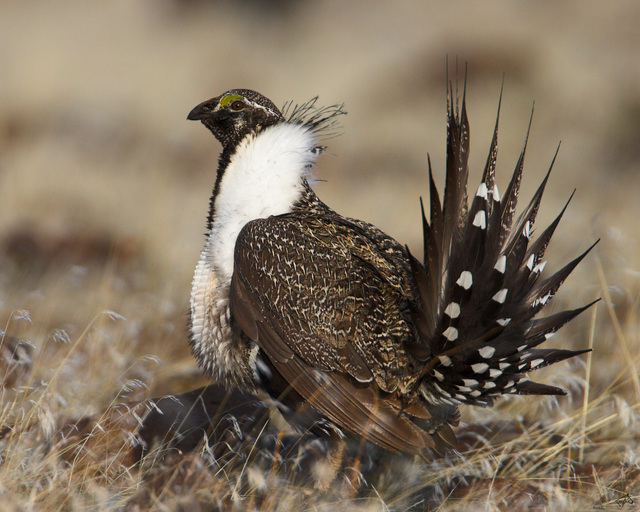
CARSON CITY — As a panel of Nevada policymakers on Wednesday adopted a new conservation plan designed to protect sage grouse habitat, the Western Governors Association has expressed concern that the multi-state effort is being treated as an afterthought by federal agencies.
Nevada’s Sagebrush Ecosystem Council adopted the newly revised 2014 state plan to protect the birds’ habitat as part of a process to avoid it from being listed by the federal government as a threatened or endangered species.
A decision on a listing is expected from the U.S. Fish &Wildlife Service in September 2015.
Such a designation would potentially pit the bird and its surviving habitat against some of Nevada’s and other western states’ biggest industries, including mining, ranching and energy development.
“Our governor’s ecosystem sagebrush council has done a phenomenal job of collecting up the best science and the best facts to put in place in Nevada and we’re even having a hard time getting our own agency, the Nevada Division of Wildlife to take it seriously,” Nye County Commissioner Lorinda Wichman said.
She said federal agencies are ignoring the plans in an attempt to control the land.
“According to the sound science and the reports I’ve been reading out of the governor’s ecosystem council there’s some minor threats, but the sage grouse numbers are right where they’re supposed to be, or better,” she said.
The birds, which can stand 2 feet tall and weigh as much as 7 pounds, occupy about 56 percent of their historical range in Nevada, which includes much of Northern Nevada and central Nevada. There is also a distinct population found along the Nevada-California border.
The Sagebrush Council, comprised of nine voting members representing ranching, local government, conservation and other interests, approved the 213-page report which outlines the strategy to conserve sage grouse habitat and halt the further decline of the species.
The plan includes a discussion of the various threats to the bird and its habitat, and sets up a credit and debit system to provide net benefits for sage grouse “while balancing the need for continued human activities vital to the Nevada economy and way of life.”
But the adoption of the plan comes as some Western governors are questioning whether the U.S. Bureau of Land Management and the U.S. Forest Service are sincerely interested in coordinating sage grouse conservation with affected states.
A letter sent Monday from Colorado Gov. John Hickenlooper and Wyoming Gov. Matt Mead, co-chairmen of the State-Federal Sage Grouse Task Force, noted that the need for closer coordination was identified in June, but that dates for such discussions were not set by the BLM until Sept. 19.
The letter states in part: “As governors, we feel that federal coordination with the states in this planning process is being ineffectually approached and treated more as an afterthought by BLM and USFS at the D.C. level. We are displeased regarding how states are being consulted with respect to an issue of such overriding importance.”
Members of the Sagebrush Council expressed differing views on the plan as adopted.
Tina Nappe, representing conservation interests on the council, called the document “on the whole a very good plan,” but she questioned whether it adequately addresses livestock grazing issues.
The state is potentially headed into a permanent drought and it might be time to evaluate how some ranching can be maintained in Nevada, but “maybe we won’t be able to retain it all,” she said.
“Some of this to me still remains very vague and is of great concern to me, particularly in light of the composition of this council,” Nappe said. “We really need to have a working group looking at the future of ranching.”
Steve Boies, representing ranching on the council, argued that the report does a good job of addressing ranching issues.
“In a lot of cases it is pretty specific to concerns that are going on out there,” he said.
J.J. Goicoechea, representing local government on the council, said the sooner the plan can be implemented on the ground, the sooner it will show its effectiveness to federal agencies.
“I know it will work and I think the vast majority of people sitting in this room know it will work,” he said. “These are some solutions that this state is going to bring forward. And we’re going to put it on the ground and we’re going to demonstrate that it will work.”
Pahrump Valley Times reporter Mark Waite contributed to this article.